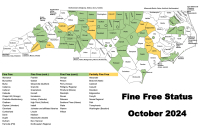With food allergies on the rise, schools grapple with how to keep students safe
 In light of the growing number of children with food allergies, a new policy has been adopted by Haywood County Schools to help parents navigate the scary terrain of sending a child with a life-threatening food allergy into an uncontrolled environment every day.
In light of the growing number of children with food allergies, a new policy has been adopted by Haywood County Schools to help parents navigate the scary terrain of sending a child with a life-threatening food allergy into an uncontrolled environment every day.
“It is an epidemic for which scientists and researchers have not found a reason,” Kelly Slate, the mom of a Riverbend Elementary student with a life-threatening nut allergy, told the school board as it was contemplating the policy earlier this year. “Avoiding the food that triggers anaphylaxis is the only cure. It is comforting to know I have a say in how my child must be protected.”
Unfortunately, it is not realistic for schools to ban certain foods, said Mark Sheppard, the support services director for the school system who oversees policies.
“Even if you banned peanut butter, look at all the other foods,” Sheppard said, listing off the other allergy biggies of wheat and dairy. “You can’t control what is going to come in in everybody’s backpack or lunchbox. Someone’s going to bring a pack of Lance Crackers.”
But under the new policy, the school system has pledged to provide a special table in the cafeteria that is designated “allergy-free” for students with severe food allergies. But it would be the student’s choice whether to sit there.
“You don’t want to punish the kid with that peanut allergy. Chances are that kid will have friends that will alter what they bring to lunch so they can sit at the table with them,” Sheppard said. “By middle school, kids are better able to control it themselves and say ‘Dude, get those Lance Crackers away from here.’”
Related Items
In the event of highly life-threatening allergies, the school could declare a classroom to be “peanut free.”
What to do if contact does occur is a critical part of the policy. It requires schools and parents to create a customized “emergency action plan” for each child, and make sure everyone is privy to the protocols.
Only about a third of school systems in the state have formal food allergy policies, putting Haywood on the front-end of what is bound to become a growing trend.
“It shows the school system is being proactive instead of reactive in response to the needs of their students,” said Jennie Boothroyd, the parent of a Canton middle-schooler with a severe gluten allergy.
Boothroyd applauded the school system for creating a clear framework for parents to work through.
“Being aware of how serious it can be is step number one,” said Boothroyd. “It does help the parent from feeling like they are being high strung.”
Sheppard said the food allergy policy will educate teachers and principals on how to be understanding, but also set parameters on what the school can realistically do to make the environment as safe as possible.
“If I had a kid with a life-threatening allergy I would be over the top, too,” Sheppard said.
It is also helpful for teachers to have written protocols that remove the guess work of which students have to avoid which foods, how serious the allergy is and how to respond if contact occurs, Boothroyd said.
Before the school will create a student food allergy plan, parents must provide medical documentation of the allergy. For example, personal food choices or suspected allergies wouldn’t warrant a customized food allergy plan for the student.
“I agree there has to be medical documentation,” said Boothroyd. “Some parents will take food sensitivity to the level of a food allergy. And some parents may push a cultural food choice, like being vegan, and call it an allergy.”









